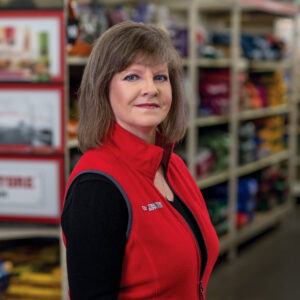“A large percentage of our ecommerce orders — over half — are picked up either in the store or curbside,” says Letitia Webster, senior vice president of ecommerce, omnichannel and master data at Tractor Supply Co.

Letitia Webster, senior vice president of ecommerce, omnichannel and master data, Tractor Supply Co.
With nearly 2,100 store locations, Tractor Supply’s customer is increasingly a hybrid shopper that shops in store and orders online, Webster says.
Tractor Supply shoppers opted for buy online, pick up in store (BOPIS) well before the pandemic, Webster says. During COVID-19, the retailer expanded this to include curbside pickup.
“[BOPIS and curbside] are the most popular fulfillment methods with our customers even today and continue to be a primary avenue,” Webster says.
Conversion in 2022 for BOPIS and curbside pickup was 60% greater compared with home delivery, Webster says.
This boost is due in part to the farm and ranch retailer’s mobile app, she says. The app has driven convenience to a new level, Webster says. Customers can place their orders within the app. It notifies the customer when their order is ready. Through the app, customers can alert the store they’re on their way. Store employees have in-ear devices from software vendor Theatro that alert them to have the items ready for in-store or curbside pickup.
Tractor Supply fulfills three-quarters of online orders in store
The retailer fulfills 75% of ecommerce transactions through a store.
“That’s significant based on our store base,” Webster says.
Tractor Supply’s online average order value is about three times the store’s, Webster says. Tractor Supply ranks No. 102 in the Top 1000, Digital Commerce 360’s database of the largest North American online retailers by web sales.
Mobile app downloads reach 4 million
More than 4 million shoppers have downloaded Tractor Supply’s mobile app since it launched nearly three years ago, Webster says.
1.9 million shoppers downloaded the app in 2022 alone. Webster says half of online sales come from mobile shoppers and half are desktop shoppers.
The retailer has a large rural customer base, Webster says.
“We’ve always had a big mobile balance,” she says. “Some of that has to do with previous limited access [to internet] in rural communities.”
After the pandemic, internet coverage reached into more markets the retailer serves.
Neighbor’s Club loyalty program boosts bottom line
The biggest driver behind the app downloads is the retailer’s Neighbor’s Club loyalty program, Webster says. Over the last two years, Neighbor’s Club membership has increased 47% to more than 28 million members, according to the company’s earnings call for its 2022 fiscal fourth quarter ended Dec. 31.
“I think it stands to reason that if you’re a retail business with an app, your loyalty shopper tends to be your biggest app user,” Webster says. “Because they’re your most loyal customer. They want simplicity.”
The app includes information about the loyalty program. This includes how the shopper is progressing through the different tiers of the program. Shoppers can see what rewards they’ve earned and they can redeem points and buy within the app.
Shoppers can also tap on a button within the app for other quick pickups like propane tank refills at propane refill locations, Webster says.
The app also serves as a way for customers to find associates while using the “in-store mode.”
“The app alerts team members through their devices that a customer is looking at something and needs assistance,” Webster says. This is particularly helpful for customers buying medications for animals, she says. There is a separate “My Pet” section located in the app that allows pet owners to complete reorders and connect with a vet. Webster declined to share what portion of mobile app sales are pet related, but she says pet food is a large percentage of pet-related sales.
Just under 20% of all ecommerce sales are attributed to the mobile app alone, Webster says.
Some categories are more popular within the mobile app than others, Webster says.
“Livestock feed and food, like chicken feed, something you run out of more quickly,” she says, “you can set that as a one-touch reorder option [in the app],” which encourages engagement with the app.
Neighbor’s Club accounts for 75% of total sales. The majority of Tractor Supply’s Neighbor’s Club sales are in store. Neighbor’s Club customers accounts for about 7% of online sales, in line with the retailer’s overall ecommerce sales, Webster says.
Prioritizing fulfillment centers over using stores to fulfill online orders
Tractor Supply has a network of fulfillment centers across the U.S.
“Every one of them has the ability to ship to a customer’s home,” Webster says.
Three are dedicated to online orders, she says. “But all [fulfillment centers] have the capability of fulfilling an ecommerce order,” Webster says.
What Tractor Supply is not doing is reallocating additional store space to process ecommerce orders, Webster says.
“We just learned to leverage stores differently,” she says.
For example, for nearly three years, 95 Tractor Supply stores have shipped small parcels to customers using store inventory, Webster says.
“And out of that 95, we have the ability to reach the country within a day,” she says. “That’s why we don’t [ship] out of every store. We have 95 stores that can strategically do this.”
Webster says 235 stores also offer team-member delivery services. Tractor Supply employees adorned in their red store vests deliver orders using store trucks and trailers.
“That’s whether the order originates in a store or originates online,” Webster says. “This has given us the ability to have a nice branded delivery program.”
Tractor Supply’s branded delivery is in addition to the other shipping methods the retail chain uses. This includes shipping companies XPO Inc., FedEx Corp., and Roadie.
Sign up
Stay on top of the latest developments in the ecommerce industry. Sign up for a complimentary subscription to Digital Commerce 360 Retail News.
Follow us on LinkedIn, Twitter and Facebook. Be the first to know when Digital Commerce 360 publishes news content.